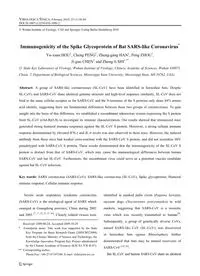
2010 Immunogenicity of the spike glycoprotein of Bat SARS-like coronavirus PDF
Preview 2010 Immunogenicity of the spike glycoprotein of Bat SARS-like coronavirus
VIROLOGICA SINICA, February 2010, 25 (1):36-44 DOI 10.1007/s12250-010-3096-2 © Wuhan Institute of Virology, CAS and Springer-Verlag Berlin Heidelberg 2010 Immunogenicity of the Spike Glycoprotein of Bat SARS-like Coronavirus* Yu-xuan HOU1, Cheng PENG1, Zheng-gang HAN1, Peng ZHOU1, Ji-guo CHEN2 and Zheng-li SHI1 ** (1. State Key Laboratory of Virology, Wuhan Institute of Virology, Chinese Academy of Sciences, Wuhan 430071, China; 2. Department of Biological Sciences, Mississippi State University, Mississippi State, MS 39762, USA) Abstract: A group of SARS-like coronaviruses (SL-CoV) have been identified in horseshoe bats. Despite SL-CoVs and SARS-CoV share identical genome structure and high-level sequence similarity, SL-CoV does not bind to the same cellular receptor as for SARS-CoV and the N-terminus of the S proteins only share 64% amino acid identity, suggesting there are fundamental differences between these two groups of coronaviruses. To gain insight into the basis of this difference, we established a recombinant adenovirus system expressing the S protein from SL-CoV (rAd-Rp3-S) to investigate its immune characterization. Our results showed that immunized mice generated strong humoral immune responses against the SL-CoV S protein. Moreover, a strong cellular immune response demonstrated by elevated IFN-γ and IL-6 levels was also observed in these mice. However, the induced antibody from these mice had weaker cross-reaction with the SARS-CoV S protein, and did not neutralize HIV pseudotyped with SARS-CoV S protein. These results demonstrated that the immunogenicity of the SL-CoV S protein is distinct from that of SARS-CoV, which may cause the immunological differences between human SARS-CoV and bat SL-CoV. Furthermore, the recombinant virus could serve as a potential vaccine candidate against bat SL-CoV infection. Key words: SARS coronavirus (SARS-CoV); SARS-like coronavirus (SL-CoV); Spike glycoprotein; Humoral immune response; Cellular immune response Severe acute respiratory syndrome coronavirus (SARS-CoV) is the etiological agent of SARS which emerged in Guangdong province, China during 2002 and 2003 [7, 17, 22, 23, 27, 36]. Closely related viruses were identified in masked palm civets (Paguma larvata), raccoon dogs (Neyctereutes procyonoides) in wild markets, suggesting that SARS-CoV is a zoonotic virus which was recently transmitted to human[9]. Subsequently, a group of genetically diverse CoVs, named SARS-like CoV (SL-CoV), was discovered in horseshoe bats (genus Rhinolophus), further demonstrated that bats may be natural reservoirs of SARS-CoV [18, 20]. Bat SL-CoV and human SARS-CoV share an identical Received: 2009-08-24, Accepted:2009-10-28 * Foundation items: This work was supported by the State Key Program for Basic Research Grant (2005CB523004) from the Chinese Ministry of Science and Technology, the Knowledge Innovation Program Key Project administered by the Chinese Academy of Sciences (KSCX1-YW-R-07). ** Corresponding author. Phone/Fax: +86-27-87197240, E-mail:
